2543
Views & Citations1543
Likes & Shares
METHODS
The study was conducted at the multi-center Central Sterile Supply Department and was an evaluation of two methods for assessing prepares the medical instruments after the surgery operation. This study was conducted in the CSSDs of five public hospitals in Thailand from August - October 2022. MEDI PLUS pre-cleaning and disinfection sprays against the microbial burden and blood stains remover on medical devices containing extracts from Thai agricultural products, including Mangosteen (Garcinia mangostana L.), and Syzygium aromaticum (L.) Merrill & Perry with Ethoxylated Alcohol active ingredients was tested in this study was obtained by applying the protocol of two studies of the dissolution time of blood stains: The methods were a test by a simple visual and blood stains test strip (Figures 1 & 2). The contact time for the removed blood stains by simple visual observation test and blood stains test strips at different times: 1, 2, 3, 4, and 5 min. In a multicenter Central Sterile Supply Department trial, 100 identical surgical devices were prepared, divided into 50 visual tests and 50 test strips, for each hospital. The study of bloodstain dissolution was performed by a simple visual in the bloodstain dissolution test by timing. The second method of bloodstain dissolution study was performed by inserting a test strip into a kidney-shaped bowl and testing the bloodstain dissolution by timing. The study on the bactericidal and antiviral properties of the product was tested by sending samples to the medical laboratories of the Faculty of Medical Technology in Thailand. One-step cleaner disinfectant following AOAC Official Methods 955.14, 955.15, 964.02, and 955.17 according to standard AOAC methods analysis (2010). Microbial burden efficiency test results, Staphylococcus aureus (ATCC 6538), Salmonella choleraesuis (ATCC 10708) Pseudomonas aeruginosa (ATCC 15442), and the dilution of samples were tested. The test of bacterial growth after exposure to 60 contaminated carriers to disinfectant at 10 min. The test of T. mentagrophytes (Trichophyton mentagrophytes) is a clinical isolate. The strain sporulates freely on culture media and produces abundant conidia as required by AOAC Official Method 955.17, AOAC International, 2000. The test microbial burden after exposure to 60 contaminated carriers to disinfectant at 10 min and the dilution of samples were tested. The fungicidal testing by the Drug Delivery System Excellence Center of the Faculty of Pharmaceutical Sciences in Thailand. The fungicidal testing of C.albicans (ATCC 90028), and C. neoformans by Minimal Inhibition Concentration (MIC) were diluted with culture media at concentrations of 90, 80, 70, 60, 50, 40, 30, 20, and 10% and then test the antifungal activity at the same concentration.
RESULT
The multi-center Central Sterile Supply Department found that the contact time for the removed blood stains by simple visual observation test in 1 min. The decomposition effect of the blood using test strips begins to react at 1 minand the hemolysis improves at 2 min and beyond (Figures 3 & 4). A significant difference in 2 min (P ≤ .005) was observed using cleaning indicators measurements. For all bacteria and viruses, ready-to-use pre-cleaning-disinfecting spray products reduced the microbial count with a log10 reduction >5 with a 10-min exposure time. The study on the bactericidal and antiviral properties of the product results, Staphylococcus aureus (ATCC 6538), Salmonella choleraesuis (ATCC 10708) Pseudomonas aeruginosa (ATCC 15442), and dilution of samples was 1:15. The test of bacterial growth after exposure to 60 contaminated carriers to disinfectant at 10 min. The test of T. mentagrophytes (Trichophyton mentagrophytes) is a clinical isolate. The strain sporulates freely on culture media and produces abundant conidia as required by AOAC Official Method 955.17, AOAC International, 2000. The information in Table 1 represents the test of microbial burden after exposure to 60 contaminated carriers to disinfectant at 10 min and the dilution of samples was 1:10. Table 2 showed the fungicidal testing of C.albicans ATCC 90028, and C. neoformans by minimal inhibition concentration (MIC) of 10%. MEDI PLUS ready-to-use pre-cleaning-disinfecting spray products for all bacteria and viruses reduced the microbial count with a log10 reduction >5 with a 10-min exposure time. All fungi reduced the microbial count with a log10 reduction >5 with a 10-min exposure time except for a spray based on natural extracts and Ethoxylated Alcohol. The findings of this study show that a ready-to-use pre-cleaning-disinfecting spray is extremely important in reducing the possible transmission of all microorganisms. 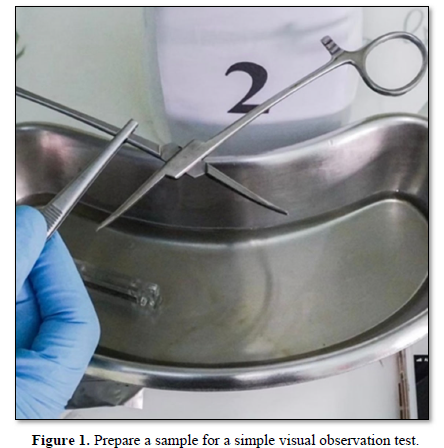
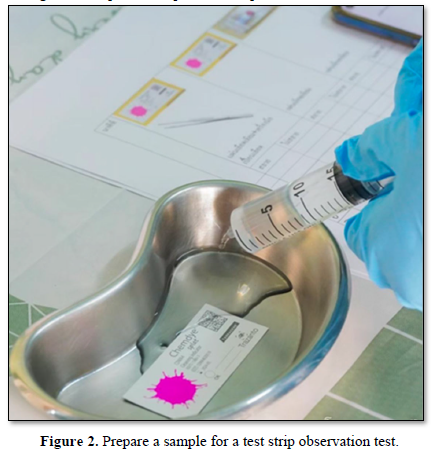
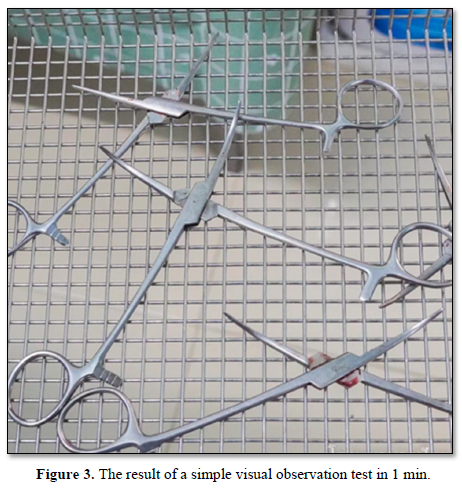
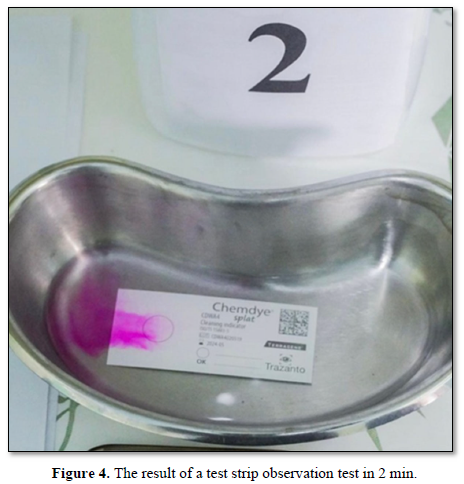
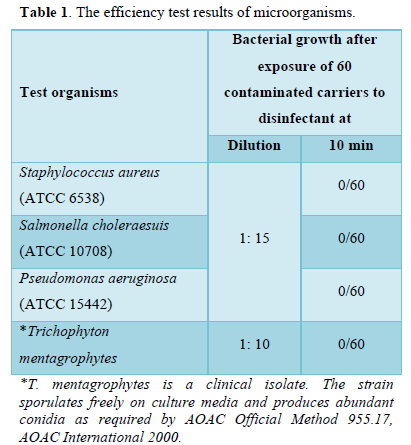
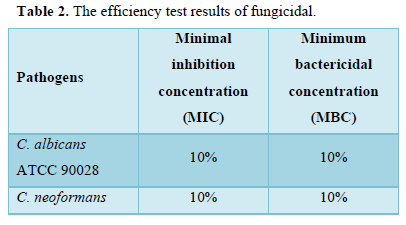
DISCUSSION
The effective pre-cleaning and disinfection sprays containing extracts from Thai agricultural products with Ethoxylated Alcohol active ingredients were high efficiencies in simultaneously cleaning, disinfecting, and removing blood stains remover on medical devices. The results of a simple visual and blood stains test strip show effective blood stain dissolution efficiency from 2 min onwards. This is in line with the study of Withaya which found that the pre-cleaning spray on blood stain remover was better than the pre-cleaning foam [1,5,6]. Thai Mangosteen extracted with Ethoxylated Alcohol active ingredients can inhibit the growth of Staphylococcus aureus (ATCC 6538), Salmonella choleraesuis (ATCC 10708) Pseudomonas aeruginosa (ATCC 15442). Most of the mangosteen extracted contains the main compound, Xanthones (more than 40 %), which is the core structure of Mangostin. Xanthones are reported to inhibit mold [7-10]. According to a study by Yenjit et al, Xanthones have been reported to inhibit fungi. Many species such as Rhizopus sp, Alternaria solani, Aspergillus niger, Aspergillus flavus, Penicillium sp, Fusarium roseum, etc. Mangosteen extract found that many bioactive compounds such as flavonoids, xanthones, and mangiferin, among others, are classified as substances that increase plant resistance and inhibit the growth of microorganisms [9,11,12]. It has also been studied which is consistent with the Sabahat study decoction and essential oil of clove (Syzygium aromaticum (L.) Merrill.& Perry) as natural antibacterial agents against 100 isolates belonging to 10 different species of Gram–ve bacilli viz, Escherichia coli, Proteus mirabilis, Pseudomonas aeruginosa, Enterobacter aerogenes, Klebsiella ozaena, Klebsiella pneumonia, Serratia marcescens, Salmonella typhi, Shigella dysentriae and Vibrio cholerae [7,12-16]. In a study carried out extracts from Thai agricultural products with Ethoxylated Alcohol active ingredients extract showed an inhibitory effect against microbial burden and blood stains remover on medical devices [17-20].
CONCLUSIONS
The findings of this study show that the effectiveness of pre-cleaning and disinfection sprays against the microbial burden and blood stains remover on medical devices containing extracts from Thai agricultural products simultaneously cleaning, disinfecting, and removing blood stains on medical devices extremely important in reducing the possible transmission of all microorganisms. The cleaning-disinfecting sprays, with ingredients from natural extracts, can remove blood stains. Instrument pre-cleaning and disinfection sprays of natural extract and Ethoxylated Alcohol showed comparable effectiveness.
LIMITATIONS OF THE STUDY
This study had some limitations due to recovery factors that may lead to a remover of blood strains in medical devices of CSSDs, such as contact time, the technique of measurement, and procedure activities. The multi-center Central Sterile Supply Department was recruited from 5 hospitals which is still a small sample. In addition, such studies have not been studied at the European Standard.
- Chanchai W, Jindarat C (2022) Comparative Double-Blind Study of Efficacy of Pre-Cleaners for Surgical Instruments and Medical Devices in the Central Sterile Services Department. J Biomed Res Environ Sci 3: 1122-1125.
- Shriyan A, Shriyan A (2015) A Study on the Efficiency of CSSD at a Health Care Centre. TJPRC: J Nurs Patient Saf Care 1: 7-16.
- Banu A, Subhas GT (2013) Central sterile supply department need of the hour. J Pub Health Med Res 1: 58-62.
- Hung CY, Lin SS (2015) The process improvement of the supplies distribution of the central sterile services department. J Microbiol Immunol Infect 48(2): 104.
- Nalin-on N (2020) The Development of Blood Stain Removal Solution from Spinach in Longer Storage at Room Temperature for Sanitation Work in Hospitals. Naresuan Uni J Sci Technol (NUJST) 29: 1-10.
- Kapoor A, Vora A, Nataraj G, Mishra S, Kerkar P, et al. (2017) Guidance on reuse of cardio-vascular catheters and devices in India: A consensus document. Indian Heart J 69: 357-363.
- Saeed S, Tariqin P (2008) In vitro antibacterial activity of clove against gram negative bacteria. Pak J Bot 40: 2157-2160.
- Yenjit P, Issarakraisila M, Intana W, Sattasalalchai S, Suwanno T, et al. (2008) Efficacy of extract substances from the pericarp of Garcinia mangostana to control major diseases of tropical fruits in laboratory. Acta Horticulture 1: 339-343.
- Exner M, Bhattacharya S, Gebel J, Bermes PG, Hartemann P, et al. (2020) Chemical disinfection in healthcare settings: critical aspects for the development of global strategies. GMS Hyg Infect Control 15: Doc36.
- Gutierrez-Orozco F, Failla ML (2013) Biological activities and bioavailability of mangosteen xanthones: A critical review of the current evidence. Nutrients 5: 3163-3183.
- Zarena AS, Sankar KU (2011) Xanthones enriched extracts from mangosteen pericarp obtained by supercritical carbon dioxide process. Sep Purf Technol 80: 172-178.
- Torrungruang K, Vichienroj P, Chutimaworapan S (2007) Antibacrial activity of mangosteen pericarp extract against cariogenic Streptococcus mutans. CU Dent J 30: 1-10.
- Suksamrarn S, Komutiban O, Ratananukul P, Chimnoi N, Lartpornmatulee N, et al. (2006) Cytotoxic prenylated xanthones from the young fruit of Garcinia mangostana. Chem Pharm Bull 54: 301-305.
- Iinuma M, Tosa H, Tanaka T, Asai F, Kobayashi A, et al. (1996) Antibacterial activity of xanthones from guttiferaeous plants against methicillin-resistant Staphylococcus aureus. J Pharm Pharmacol 48: 861-865.
- Chomnawang MT, Surassmo S, Nukoolkarn VS, Gritsanapan W (2005) Antimicrobial effects of Thai medicinal plants against acne-inducing bacteria. J Ethnopharmacol 101: 330-333.
- Mohamed GA, Ibrahim SRM, Shaaban MIA, Ross SA (2014) Mangostan axanthones I and II, new xanthones from the pericarp of Garcinia mangostana. Phytotherapia 98: 215-221.
- CDC (2015) Identifying Healthcare-associated Infections.
- Rutala WA, Gergen MF, Weber DJ (2014) Efficacy of a Washer-Disinfector in Eliminating Healthcare-Associated Pathogens from Surgical Instruments. Inf Control Hospital Epidemiol 35: 883-885.
- Banu A, Subhas GT (2013) Central Sterile Supply Department-Need of The Hour. J Pub Health Med Res 1: 58-62.
- Ibrahim MY, Hasim NM, Mariod AM, Mohan S, Abdulla MA, et al. (2014) α-Mangostin from Garcinia mangostana Linn: An updated review of its pharmacological properties. Arab J Chem 4: 123-129.
QUICK LINKS
- SUBMIT MANUSCRIPT
- RECOMMEND THE JOURNAL
-
SUBSCRIBE FOR ALERTS
RELATED JOURNALS
- Journal of Carcinogenesis and Mutagenesis Research (ISSN: 2643-0541)
- Journal of Otolaryngology and Neurotology Research(ISSN:2641-6956)
- Journal of Infectious Diseases and Research (ISSN: 2688-6537)
- Journal of Nursing and Occupational Health (ISSN: 2640-0845)
- Journal of Neurosurgery Imaging and Techniques (ISSN:2473-1943)
- Chemotherapy Research Journal (ISSN:2642-0236)
- Journal of Blood Transfusions and Diseases (ISSN:2641-4023)





